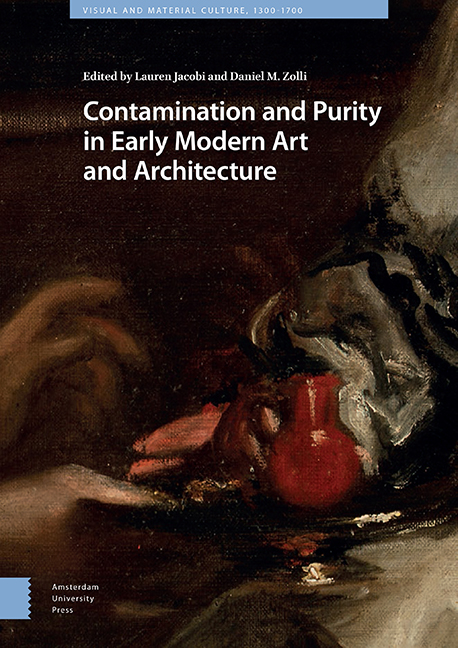Book contents
- Frontmatter
- Contents
- List of Illustrations
- Introduction: Contamination and Purity in Early Modern Art and Architecture
- 1 Generation and Ruination in the Display of Michelangelo’s Non-finito
- 2 The Sacrilege of Soot: Liturgical Decorum and the Black Madonna of Loreto
- 3 Sedimentary Aesthetics
- 4 ‘Adding to the Good Silver with Other Trickery’ : Purity and Contamination in Clement VII’s Emergency Currency
- 5 Tapestry as Tainted Medium: Charles V’s Conquest of Tunis
- 6 Bruegel’s Dirty Little Atoms
- 7 Leakage, Contagion, and Containment in Early Modern Venice
- 8 Contamination, Purification, Determinism: The Italian Pontine Marshes
- 9 Colonial Consecrations, Violent Reclamations, and Contested Spaces in the Spanish Americas
- 10 Contamination | Purification
- Index
10 - Contamination | Purification
Published online by Cambridge University Press: 27 May 2021
- Frontmatter
- Contents
- List of Illustrations
- Introduction: Contamination and Purity in Early Modern Art and Architecture
- 1 Generation and Ruination in the Display of Michelangelo’s Non-finito
- 2 The Sacrilege of Soot: Liturgical Decorum and the Black Madonna of Loreto
- 3 Sedimentary Aesthetics
- 4 ‘Adding to the Good Silver with Other Trickery’ : Purity and Contamination in Clement VII’s Emergency Currency
- 5 Tapestry as Tainted Medium: Charles V’s Conquest of Tunis
- 6 Bruegel’s Dirty Little Atoms
- 7 Leakage, Contagion, and Containment in Early Modern Venice
- 8 Contamination, Purification, Determinism: The Italian Pontine Marshes
- 9 Colonial Consecrations, Violent Reclamations, and Contested Spaces in the Spanish Americas
- 10 Contamination | Purification
- Index
Summary
Abstract
Semantically, contamination is a process of defilement, while purity is a condition. This chapter takes up anthropology's interest in process to inquire about purification itself as an historical production. It comments on the recent ‘material turn’ in art history and the humanities more generally. Linked to drives toward purity, grounded ‘material’ was asserted by the Fascists in contradistinction to ethereal abstraction, craft claimed over concept, and rooted contact with soil privileged over nomadic cosmopolitans. Likewise, linked to contamination, ‘base material’ was asserted against the modernist art world to contest fetishes of purity. While contemporary invocations of material have been a good way of disputing teleology, this chapter demonstrates they often are agnostic regarding narratives they might be made to serve.
Keywords: purification, materiality, ritual, Judaism, fascism, pollution
1520 / 1920
Four hundred years separate the two portraits of the Virgin Mary. Both are coy in their reference to her, and both can either purify or contaminate, depending on how they are beheld. One was published in March 1920 by the French Dadaist Francis Picabia; the other dates from around 1520 and is the work of one of the greatest painters and printmakers of Renaissance Germany (Figs. 10.1, 10.2). Albrecht Altdorfer engraved his image on a copper plate about two inches square and printed it on bits of paper not much larger than postage stamps, necessitating and rewarding close perusal, one viewer at a time. Picabia used photolithography to reproduce an original inkblot. Splashed on a sheet of paper measuring 8 by 13 inches, the blot – still extant – was mechanically transferred onto a broadsheet emblazoned with the artist's name and cryptic title: La Sainte Vierge. This sheet was folded and inserted into the twelfth issue of a magazine, artistic and literary, which the artist had founded in Barcelona beginning in 1917 and dubbed 391 (echoing and superseding the New York arts magazine 291). Picabia's La Sainte Vierge would have been handled and viewed like a newspaper. Spread open on a viewer's lap or unfolded on a desk or table, it could have been pondered alone, or perhaps shared in hilarious blasphemy.
- Type
- Chapter
- Information
- Contamination and Purity in Early Modern Art and Architecture , pp. 315 - 360Publisher: Amsterdam University PressPrint publication year: 2021



